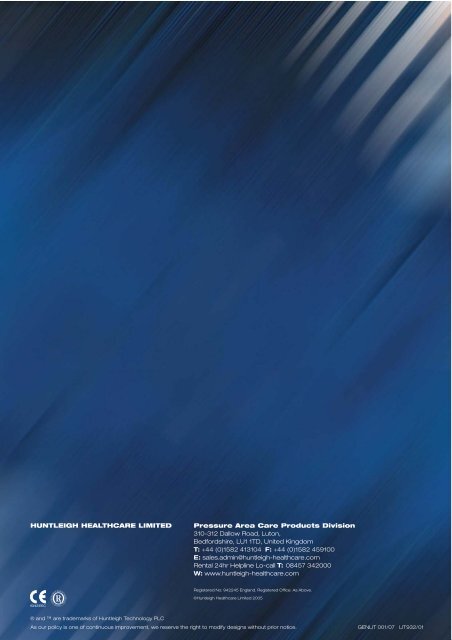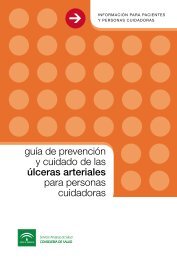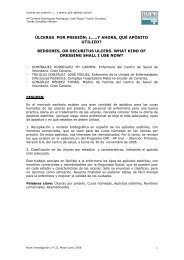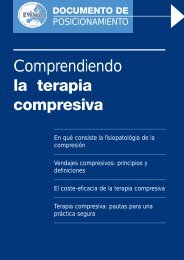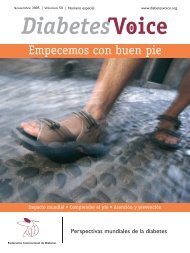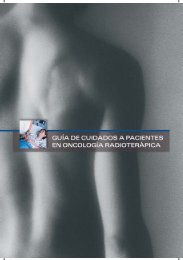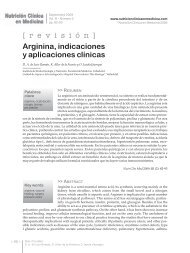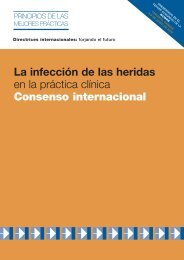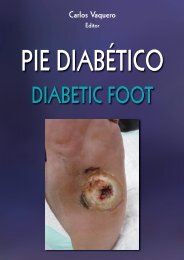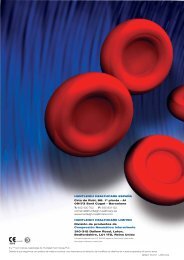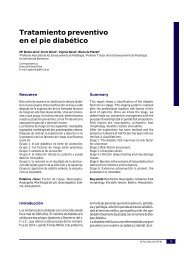HUNTLEIGH HEALTHCARE LIMITED Pressure Area Care Products ...
HUNTLEIGH HEALTHCARE LIMITED Pressure Area Care Products ...
HUNTLEIGH HEALTHCARE LIMITED Pressure Area Care Products ...
You also want an ePaper? Increase the reach of your titles
YUMPU automatically turns print PDFs into web optimized ePapers that Google loves.
<strong>HUNTLEIGH</strong> <strong>HEALTHCARE</strong> <strong>LIMITED</strong><br />
<strong>Pressure</strong> <strong>Area</strong> <strong>Care</strong> <strong>Products</strong> Division<br />
310-312 Dallow Road, Luton,<br />
Bedfordshire, LU1 1TD, United Kingdom<br />
T: +44 (0)1582 413104 F: +44 (0)1582 459100<br />
E: sales.admin@huntleigh-healthcare.com<br />
Rental 24hr Helpline Lo-call T: 08457 342000<br />
W: www.huntleigh-healthcare.com<br />
Registered No: 942245 England. Registered Office: As Above.<br />
©Huntleigh Healthcare Limited 2005<br />
® and are trademarks of Huntleigh Technology PLC<br />
As our policy is one of continuous improvement, we reserve the right to modify designs without prior notice.<br />
GENLIT 001/07 LIT932/01
Principles of Alternating <strong>Pressure</strong><br />
THE LOGICAL METHOD OF PRESSURE ULCER AVOIDANCE
Introduction<br />
Alternating <strong>Pressure</strong> Air<br />
Mattresses<br />
<strong>Pressure</strong> ulcers, defined as localised<br />
damage to the skin and the underlying tissue<br />
caused by a combination of pressure, shear,<br />
and friction (Allman 1997), continue to<br />
present a major health problem.<br />
The formation of pressure ulcers is complex<br />
and not fully understood, yet the availability<br />
and use of high-technology pressurerelieving<br />
support surfaces has escalated in<br />
the past decade, with an extensive range of<br />
equipment now available. However, product<br />
selection remains complex, as it cannot be<br />
assumed that the key principles of pressure<br />
relief have been incorporated into all the<br />
devices available and not all features have<br />
clinical relevance.<br />
This brochure is designed to provide both<br />
the technical and clinical attributes of<br />
pressure-relieving mattresses. It will explain<br />
the physiological basis for using alternating<br />
pressure as the modality of choice in the<br />
prevention and management of pressure<br />
ulcers. It will also explain the optimum<br />
performance characteristics of pressure<br />
relieving support surfaces and how these<br />
can be objectively measured.<br />
Evolution gave us spontaneous movement<br />
as the best method for pressure ulcer<br />
avoidance.<br />
Huntleigh Healthcare offers alternating<br />
pressure to assist nature at times of<br />
increased vulnerability.<br />
Contents<br />
Page<br />
Critical Factors in <strong>Pressure</strong> Ulcer<br />
Development 1<br />
• Anatomy of the Skin 1<br />
• Formation of <strong>Pressure</strong> Ulcers 1<br />
• How <strong>Pressure</strong> Effects Tissue 1<br />
• The 32mmHg Myth 2<br />
• Contributing Factors to Tissue<br />
Damage 2<br />
• The Natural Method of Relieving<br />
<strong>Pressure</strong> 3<br />
Types of Support Systems 4<br />
• <strong>Pressure</strong> Reducing Support<br />
Surfaces 4<br />
• <strong>Pressure</strong> Relieving Support<br />
Surfaces 4<br />
Support Systems – Performance<br />
Measurement 5<br />
• Cycle Amplitude 5<br />
• Maximum and Minimum Interface<br />
<strong>Pressure</strong>s 5<br />
• Average Interface <strong>Pressure</strong> 5<br />
<strong>Pressure</strong> Relief Index (PRI) 6<br />
• High PRI Performance 6<br />
• How PRI is Measured 7<br />
• Support Systems – Designing an<br />
Optimum Solution 8<br />
• Comfort and Inflation <strong>Pressure</strong> 8<br />
• Adjustment to Individual Patients 9<br />
• Does Automatic MEAN Automatic? 9<br />
• Huntleigh Healthcare’s Design<br />
Criteria 10<br />
Summary 12
Critical Factors in <strong>Pressure</strong> Ulcer Development<br />
Anatomy of the Skin<br />
The skin is the largest organ in the body and accounts for 15% of the total body weight.<br />
It receives a third of the body’s circulating blood volume 1 . Blood vessels supply<br />
nutrients and oxygen to the skin cells and lymph vessels assist the removal of<br />
metabolites and maintain correct fluid balance.<br />
Structures such as muscle and fat have similar basic elements; however the physical<br />
structure differs depending on the exact tissue type.<br />
Formation of <strong>Pressure</strong> Ulcers<br />
A pressure ulcer can be described as an area of localised<br />
damage resulting from the combined effects of unrelieved<br />
PRESSURE, SHEAR AND FRICTION 2 . Subcutaneous<br />
tissue and muscle can be more easily damaged by<br />
pressure than the overlaying skin 3 .<br />
The formation of pressure ulcers is complex and not fully<br />
understood, however the basic process involves the<br />
constriction of small blood vessels as a result of<br />
compression and/or distortion of the soft tissues. This<br />
causes an insufficient supply of essential nutrients and<br />
oxygen, together with a build up of waste products from cell<br />
metabolism.<br />
Figure 1 – <strong>Pressure</strong> ulcer<br />
Over time, tissue viability decreases and irreversible tissue breakdown and necrosis<br />
occur 1 .<br />
How <strong>Pressure</strong> Affects Tissue<br />
Critical determinants of pressure ulcer development, have been described as; the<br />
intensity and duration of pressure which together, affect the health of soft tissue and<br />
it’s supporting structures 4 . <strong>Pressure</strong> typically means contact pressure measured<br />
between the skin and the surface and not the air pressure in an air mattress cell.<br />
<strong>Pressure</strong> ulcers may result from short periods of high contact pressure or long periods<br />
of comparatively low contact pressure 5 .<br />
SOME WORK SUGGESTS THAT THE TIME FACTOR IS ACTUALLY MORE IMPORTANT<br />
THAN THE PRESSURE INTENSITY 6 .<br />
The intensity of contact pressure required to occlude a vessel is related to the pressure<br />
of fluid (blood or lymph) flowing within: this is measured in mmHg.<br />
1
Critical Factors in <strong>Pressure</strong> Ulcer Development<br />
The 32 mmHg Myth<br />
32 mmHg (contact pressure) has<br />
previously been viewed as a universal<br />
threshold of effective therapy,<br />
however, studies show otherwise.<br />
<strong>Pressure</strong>s measured at skin level in<br />
healthy volunteers revealed a wide<br />
range/pressures across the capillary<br />
bed, with very low pressures found in<br />
the venous vessels 7 (fig 2).<br />
Figure 2 – Blood vessel network<br />
Recent work suggests that the average functional operating pressure is 17 mmHg for<br />
the entire capillary bed 8 while clinical evidence suggests that surface pressures less<br />
than 20-30 mmHg allow continuous capillary perfusion and avert ischemia, cell death<br />
and necrosis 9 . However, these figures will still vary depending on the general condition<br />
of the patient and in many cases will be considerably lower.<br />
For example, in debilitated, hypotensive patients blood flow regulation is only partially<br />
effective, which may result in pressure damage occurring at relatively low external<br />
pressures 1 . It is apparent that there are wide variations in an individuals ability to resist<br />
pressure, so 32 mmHg should not be viewed as a universal threshold of effective<br />
therapy and in many cases will be considerably lower, particularly when those<br />
pressures are unrelieved (constant low pressure).<br />
Contributing Factors to<br />
Tissue Damage<br />
As outlined previously, the time<br />
factor is a major contributing factor<br />
to tissue damage.<br />
<strong>Pressure</strong> is the combination of the<br />
weight of the body pushing down on<br />
the mattress or chair resisting it.<br />
Figure 3 – <strong>Pressure</strong> and friction effects on the tissue<br />
The way in which our body weight is<br />
transmitted through the skeleton will determine how much<br />
pressure is being exerted, i.e. duration and positioning is a factor<br />
which could result in higher pressures being exerted on soft<br />
tissues near bony prominences. This creates high pressure<br />
gradients causing significant damage deep within the tissues 10,11<br />
(fig 3).<br />
Friction is the result of the movement of our skin against another<br />
surface. This causes scuffing or grazing to the top layer of the<br />
skin.<br />
Figure 4 – Effects of shear on the<br />
tissue<br />
2
In addition to direct pressure, endothelial damage of the microvasculature can result<br />
from shear forces.<br />
Shearing is a result of gravity pulling the body down onto a surface, especially with<br />
inclined supports and excessive skin friction (fig 4).<br />
These forces can cause a significant reduction in blood flow as vessels stretch, kink or<br />
tear 12 , resulting in reduced blood flow and ischemia. Distortion of blood vessels can<br />
also disrupt the endothelium and activate the intrinsic clotting mechanism, leading to<br />
platelet aggregation (clotting), which can occlude the affected vessel leading to<br />
ischemic necrosis of dependent tissue.<br />
The Natural Method of Relieving <strong>Pressure</strong><br />
A healthy person avoids tissue trauma by means of<br />
frequent spontaneous movement even during sleep.<br />
Patient groups, such as the elderly 13 and paraplegics 14<br />
move less frequently predisposing them to pressure<br />
ulcers. Patients under the influence of sedatives also<br />
tend to move less frequently, increasing the risk<br />
level. The ideal movement pattern is one which<br />
resembles that of healthy individuals – approximately<br />
one movement every five minutes 15,16 .<br />
Alternating support surfaces mimic natural sleep<br />
movement patterns and avoid long term<br />
pressurisation of tissue (present in static surfaces),<br />
affording protection against ischemia. An additional<br />
benefit is that the theoretical flow-rate of blood is<br />
significantly greater in vessels which fully recover<br />
their round shape than those which remain<br />
permanently semi-occluded 17 (fig 5). Figure 5<br />
illustrates this phenomenon, with blood flow through<br />
the same vessel held partially closed (purple line).<br />
Figure 5 – Variation of blood flow with vessel diameter<br />
Summary<br />
The external factors which affect the blood supply to tissues are paramount in the<br />
aetiology of pressure ulcers. The most crucial external factors are recognised as;<br />
• <strong>Pressure</strong><br />
• Time<br />
• Shear and friction<br />
Prevention and therapy support systems must therefore be designed to deliver<br />
sufficient relief from pressure and shear which is effective over time. The time varying<br />
support characteristics of systems must be analysed and optimised for maximum<br />
clinical effectiveness.<br />
3
Types of Support Systems<br />
Physiologically, the body requires an<br />
environment which provides adequate<br />
nutritional supply to and metabolite removal<br />
from various tissues. There are two main<br />
groups of support surfaces which are used<br />
for pressure ulcer prevention and therapy.<br />
All surfaces are designed to ‘redistribute<br />
pressure’.<br />
<strong>Pressure</strong> Reducing Support<br />
Surfaces<br />
“The reduction of interface pressure, not<br />
necessarily below capillary-closing<br />
pressure” 18<br />
Figure 6 – Difference between pressure reducing and pressure<br />
relieving systems<br />
<strong>Pressure</strong> reduction products (i.e. static<br />
powered or non-powered support surfaces<br />
such as low air loss, foam or gel devices) attempt to address areas of high contact<br />
pressure such as those over bony prominences, by redistributing the body mass over a<br />
greater surface area. This is generally achieved by a process of immersion. As the<br />
support surface is softened, more of the body comes in contact, mass is more evenly<br />
distributed and contact pressures fall.<br />
However, contact pressures, even if low, are constant which is not a normal<br />
physiological state and in many cases the pressures are still sufficient to occlude or<br />
partially occlude the vessels.<br />
<strong>Pressure</strong> Relieving Support Surfaces<br />
“<strong>Pressure</strong> relief is the achievement of pressures below capillary-closing<br />
pressure” 18<br />
Periodic removal of pressure is achieved when we naturally change position or posture<br />
and is relieved to the extent that blood is virtually guaranteed to flow.<br />
However, pressure must be relieved for long enough to make a clinical difference 19 .<br />
If this can happen regardless of body topology – that is not dependent on the build of a<br />
patient etc., then an advantage is gained in terms of consistency of treatment. The<br />
practice of regular 2-hourly turning is a laudable, if somewhat limited method of<br />
mimicking this natural process because of patient condition, nursing time and<br />
resources etc. As early as 1948, the automation of systematic pressure relief, led to a<br />
decrease in the incidence of pressure ulcers in an understaffed spinal unit 20 . Today, the<br />
use of alternating therapy is routine, in even the most vulnerable patient population,<br />
because of consistently beneficial clinical outcomes.<br />
4
Support Systems – Performance Measurement<br />
Cycle Amplitude<br />
The loading cycle needs to be of sufficient<br />
amplitude and duration to 'lift' the body clear of the<br />
deflating cell for long enough to allow reperfusion.<br />
Systems with high amplitude that achieve a low<br />
pressure but only for a short duration are unlikely<br />
to allow sufficient reperfusion; especially in people<br />
with compromised neuro-vascular function (fig 7).<br />
Systems with low amplitude perform similarly to<br />
constant low pressure devices and may not elicit a<br />
normal hyperaemic response (Fig 8).<br />
Figure 7 – Maximum and minimum interface pressures<br />
Maximum and Minimum Interface <strong>Pressure</strong>s<br />
In the past, alternating pressure air mattress systems (APAM) have been assessed by a<br />
number of techniques. One method looked at maximum and minimum pressures<br />
achieved. This is an inaccurate method because although a very low pressure may be<br />
achieved, it still does not provide an accurate idea of actual performance (fig 7). For<br />
instance, an APAM which reaches zero pressure for just 1 second, can be rated as high<br />
as a system relieving pressure for 5 minutes. This cannot be correct, and scientists<br />
have indicated that:<br />
“Alternating pressure…. in which the skin is relieved of all pressure for 5 minute<br />
intervals…. does not result in ulceration” 21<br />
Average Interface <strong>Pressure</strong><br />
Average Interface <strong>Pressure</strong>s have also been used to analyse APAM performance.<br />
Figure 8 shows the response of a true alternating system compared to a ‘modulating’ or<br />
static system. Although the averages may be identical, the pressure relief achieved is<br />
totally different. This is because no account is taken of the minimum interface pressure<br />
achieved or for how long it remained there during<br />
the cycle. It is for this reason that average<br />
pressures cannot be used to compare these<br />
systems with true APAMs 22 .<br />
The variation of pressure with time MUST be<br />
analysed when assessing an alternating system.<br />
“Ideally, one should consider multiple<br />
thresholds, with each level determined by the<br />
patient’s peripheral circulation” 23 5<br />
Figure 8 – Response of a true alternating system<br />
compared to a modulating/static system
Support Systems – Performance Measurement<br />
Therefore, choosing thresholds close to arteriolar, capillary and venule operating<br />
pressures (30, 20 and 10 mmHg), will help to indicate an APAM’s effectiveness.<br />
Clearly, the greater the time spent under each threshold… the better! In particular, the<br />
20 and 10 mmHg thresholds 24,25 which are clinically more important.<br />
<strong>Pressure</strong> Relief Index<br />
The ability of an APAM to relieve pressure below<br />
clinically relevant thresholds is measured by<br />
calculating the <strong>Pressure</strong> Relief Index (PRI) over a<br />
set time.<br />
Figure 9 illustrates the PRI technique with a typical<br />
interface (contact) pressure/time tracing for a<br />
correctly inflated APAM.<br />
Figure 9 – PRI technique with a typical interface<br />
pressure/time tracing for a correctly inflated APAM<br />
Figure 9 shows that interface pressure remained<br />
below 20 mmHg for 4 out of 10 minutes, giving a<br />
PRI of 40%, below 10 mmHg, the PRI was 20%, and so on.<br />
An easy to understand figure to identify a system’s PRI could be measured in minutes<br />
per hour below a certain threshold. For example, 40% PRI
ecent studies have demonstrated increased flow rates at<br />
low pressures for both healthy subjects 28, 29 and those with<br />
impaired neuro-vascular response 30 . Figure 11 shows how<br />
the blood flow was affected by contact pressure.<br />
The use of alternating surfaces has also been shown to be<br />
important in the promotion of reactive hyperaemia and is<br />
often cited as a key benefit of the surfaces. Reactive<br />
hyperaemia is a normal physiological response to pressure<br />
relief and is the process by which the body increases<br />
blood flow to tissues that have temporarily been deprived<br />
of oxygen, so as to restore the natural balance 6 , this<br />
should not be confused with non-reactive hyperaemia<br />
which is a grade 1 ulcer.<br />
Figure 11 – The effect of contact pressure on<br />
blood flow in a human forearm<br />
The clinical implications of using alternating surfaces are measurable. A comparison of<br />
alternating systems with “equivalent” static (pressure reducing) systems in an Intensive<br />
<strong>Care</strong> Unit, showed a significant reduction in the development of pressure ulcers on<br />
patients nursed on alternating surfaces 31 .<br />
How PRI is Measured<br />
The <strong>Pressure</strong> Relief Index can be used as an assessment<br />
tool to measure the performance of alternating surfaces<br />
such as mattresses and cushions. Interface pressure (the<br />
pressure existing between the support surface and the<br />
test subject) is recorded using a single sensor (e.g. an<br />
Oxford <strong>Pressure</strong> Monitor) which is attached to a computer.<br />
As shown in Fig 12, the sensor is secured over a bony<br />
prominence; typically, the heel, sacrum, ischial tuberosities<br />
and trochanter. Tests can then be performed in the<br />
supine, side lying or sitting positions.<br />
PRI refers to the percentage of time (threshold) for one<br />
complete cycle of an alternating surface, that the interface<br />
pressure is below a predefined pressure. The predefined<br />
pressures used in mattress assessments are:<br />
Figure 12 – The pressure sensor attached to<br />
the heel and a graph of the results<br />
30 mmHg – relating to the average blood pressure at the<br />
arteriolar end of the microcirculation.<br />
20 mmHg – relating to the average blood pressure in the capillary loops.<br />
10 mmHg – relating to the average blood pressure in the venules.<br />
These pressures relate approximately to the closing pressures of blood vessels at heart<br />
level as measured by E.M Landis (1930) 7 . The interface pressures exerted by a seating<br />
surface are higher due to the smaller contact area, and blood pressure is also higher<br />
since a column of blood exists between the heart and the buttocks. So the defined<br />
pressures used for PRI measurement are set higher; 60 mmHg, 40 mmHg and 20 mmHg.<br />
7
Support Systems – Performance Measurement<br />
Support Systems – Designing an Optimum Solution<br />
Performance measurements such as PRI are<br />
extremely useful tools, but only to measure<br />
pressure relief. In an extreme case, a high PRI<br />
value could be achieved by steel girders<br />
alternately moving under a patient (fig 13).<br />
Therefore, without knowledge of patient<br />
compliance, accurate judgements cannot be<br />
made. A system needs to provide sufficient<br />
COMFORT to satisfy psychological and sensory<br />
requirements, as well as provide effective<br />
pressure relief.<br />
Figure 13 – High PRI value could be achieved by steel<br />
girders moving alternatively<br />
A support surface consensus group 32 concluded that there were three main clinical<br />
purposes of a support system:<br />
• POSTURAL CONTROL (via appropriate positioning aids)<br />
• COMFORT (via the support surface)<br />
• PRESSURE MANAGEMENT (via the support surface)<br />
In combination with appropriate bed frames, APAMs should meet all three<br />
requirements.<br />
Comfort and Inflation <strong>Pressure</strong><br />
In air systems, comfort is related primarily to cell<br />
inflation pressure and the rate of change of<br />
pressure during the cycle. A high inflation<br />
pressure prevents ‘bottoming out’, but leads to<br />
discomfort and high peak contact pressures.<br />
A low inflation pressure can increase comfort, but<br />
limits weight carrying capacity to support the<br />
patient, therefore increasing the likelihood of<br />
‘bottoming out’. This situation is shown in<br />
simplified form (fig 14).<br />
The shape of patient response curves change with<br />
posture and body mass distribution. However, it is<br />
generally true that the optimal support pressure<br />
for comfort may not be equivalent to that required<br />
for maximum pressure relief. An effective APAM Figure 14 – Optimum inflation pressure and comfort<br />
must ensure that a careful balance is struck<br />
between pressure relief and comfort and must be<br />
able to be ‘tuned’ to the patient’s individual characteristics and requirements 33 .<br />
8
Adjustment to Individual Patients<br />
‘Tuning’ an APAM is possible in two ways: manual and automatic.<br />
Manual Adjustment<br />
This approach is most appropriate for patients who can tolerate some degree of risk<br />
should they be placed upon a system which may be under or over inflated i.e. those<br />
who are able to make independent postural changes. However, the presence of<br />
experienced staff is needed in order to set the appropriate pressure levels. If these<br />
two factors are present, then manual adjustment represents value for money and<br />
clinically effective therapy 34 .<br />
Automatic Adjustment<br />
If staff are not available to optimise system settings or patients cannot tolerate over or<br />
under inflation, i.e. highly vulnerable patients, then an automatic device is<br />
recommended. Automatic adjustment is achieved by periodic adjustment of the<br />
pump’s pressure control once the patient has been placed on to the support surface.<br />
This is repeated until sufficient clearance is achieved and the patient is well supported.<br />
These systems also have more sophisticated alarm and monitoring functions which<br />
offer advanced warning of potential dangers to higher risk patients if a failure occurs.<br />
Automatic systems maintain high levels of comfort and pressure relief (PRI)<br />
REGARDLESS of patient weight or posture, by adjusting internal cell pressures in<br />
response to individual body mass distribution; they have also been shown to be<br />
clinically effective 35 .<br />
In the more sophisticated mattresses, tuning to individual patient characteristics can be<br />
demonstrated using laboratory techniques such as PRI and laser doppler studies 36 .<br />
These techniques can demonstrate systems such as the AUTO logic system 29 and<br />
more so the NIMBUS logic system 37 produce idealised physiological responses in a<br />
range of individuals.<br />
Does Automatic MEAN Automatic?<br />
It can be said that by optimising inflation pressures, the benefit of high pressure relief is<br />
achieved simultaneously with enhanced comfort.<br />
Many manufacturers claim their systems are either automatic or have automatic<br />
adjustment. Rithalia and Heath 38 evaluated the ability of four different APAM systems to<br />
adapt automatically to changes in posture and weight in healthy volunteers, by<br />
monitoring inflation pressure inside the air cells as subjects move through supine,<br />
lateral and semi-recumbent positions. It was evident that only the Nimbus ® 3 system<br />
changed pressures to suit the new positions of the subjects.<br />
When subject mass was considered, it was shown that with an increase in weight there<br />
was a corresponding increase in inflation pressure for the Nimbus 3 system, whereas<br />
subject mass appeared to have no effect on inflation pressure for the other APAMs.<br />
9
Support Systems – Performance Measurement<br />
The automatic adjustment of Nimbus 3 systems have shown to respond to all changes<br />
in patients position and weight, thereby helping to achieve optimum comfort and<br />
pressure relief. This is supported by both clinical outcome and qualitative studies.<br />
In a randomised controlled study, results indicated that not only did the Nimbus 3<br />
system provide excellent outcomes in sacral ulcers, it was also significantly more<br />
effective than the comparator in healing heel ulcers 39 . Studies have also shown the<br />
Nimbus 3 system to be perceived as more comfortable over the other APAMs by the<br />
patient population 40 .<br />
Automatic adjustment implies continuous monitoring and adaptation of inflation<br />
pressure to individual patient requirements and not simply the maintenance of a<br />
constant single pressure.<br />
Huntleigh Healthcare’s Design Criteria<br />
Achieving high pressure relief (i.e. high PRI) while optimising comfort for each individual<br />
patient is a difficult but achievable goal. All Huntleigh APAM’s (mattresses and<br />
overlays) are based on design concepts geared to physiological requirements, which<br />
include:<br />
1. CONSISTENT PRESSURE RELIEF<br />
It has been reported that:<br />
“<strong>Pressure</strong> relief, below 20-30 mmHg is the cornerstone of the therapy of pressure<br />
ulcers” 41 .<br />
Huntleigh Healthcare views this as a MINIMUM STANDARD, where the lowest level is<br />
often exceeded by achieving substantial PRIs below even 10 mmHg. Independent tests<br />
have shown that Huntleigh Healthcare’s support systems, achieve a high degree of<br />
pressure relief compared with other products available in the market place 42,43,44 .<br />
2. 1-IN-2 CELL CYCLE<br />
This is important primarily because it provides a<br />
balanced regime of vessel occlusion followed by<br />
the pressure relief and re-establishment of flow.<br />
In other cycles such as 1-in-3 or 1-in-4 (fig 15),<br />
pressure is applied for longer, which could lead to<br />
increased heat build-up, sweating and greater<br />
metabolic demand 45 . Research has already<br />
shown that longer periods of pressure are<br />
associated with longer tissue oxygen recovery<br />
times 46 . In elderly patients, recovery can take up<br />
to two and a half times as long as in healthy<br />
people 47 .<br />
A balanced cycle, therefore aims, to MATCH<br />
loading time with recovery time.<br />
Figure 15 – Differences between different alternating<br />
cycles<br />
10
Rithalia and Gonsalkorale 48, 49 , measured mean pressure, mean maximum and mean<br />
minimum interface pressure, in which a 2 in 1 cell design APAM (Nimbus 3 system) was<br />
compared to a 1 in 3 cell design surface. A continuous recording technique was used<br />
to ascertain the number of minutes/hours that the interface pressure at a given<br />
anatomical site was below 10, 20 and 30 mmHg. Considerable differences were seen<br />
between sites (sacrum, ischial tuberosities, trochanter and heels).<br />
The 1 in 2 cycle produces a sufficiently long period of pressure relief to allow TISSUE<br />
OXYGEN to recover to the ‘normal’ level (that recorded prior to the subject resting on<br />
the mattress). The automatic 2 cell system (Nimbus 3 system) recovered<br />
transcutaneous (tissue) oxygen and carbon dioxide levels close to normal levels, at<br />
regular intervals. This reinforces the advantage of a high PRI and shows that the<br />
pattern of pressure relief matches the maintenance of tissue perfusion at contact sites.<br />
The results suggest that the method of reporting pressures as a percentage of time<br />
below 10, 20 and 30 mmHg is meaningful to allow tissue perfusion to be maintained.<br />
3. CLINICALLY RELEVANT ALTERNATING FREQUENCY<br />
Research has shown that healthy individuals move at approximately 5 minute intervals<br />
during sleep 16 . Past work involving at-risk patients has shown that those moving more<br />
than 54 times in 7 hours (i.e. once every 7-8 minutes) are less likely to develop<br />
pressure ulcers 50 . A MINIMUM MOVEMENT requirement for patients of once every 11.6<br />
minutes has also been recommended 51 . Thus, a cycle time of 10 minutes (5 minutes<br />
on, 5 minutes off) provides a movement pattern similar to that chosen by nature and in<br />
excess of that recommended by clinical studies. On this basis, all Huntleigh Healthcare<br />
<strong>Pressure</strong> <strong>Area</strong> Management surfaces offer no compromise.<br />
4. ADJUSTABILITY<br />
Support pressures need to be adjusted to accommodate individual patient weight,<br />
position and sensitivity. Low inflation pressures increase the risk of ‘bottoming out’ with<br />
heavier patients and cause difficulties with patient handling. High pressures condemn<br />
lightweight patients to discomfort and do not guarantee high pressure relief (PRI).<br />
Adjustment, either manual or automatic, MUST be a choice open to the care giver in<br />
order to provide pressure area management unique to each patient.<br />
11
Summary<br />
Although many devices exist, their effectiveness is not uniform even when they appear<br />
to be of similar construction. The key principle of pressure relief is not always<br />
understood and design may be driven by manufacturing and pricing considerations<br />
rather than by clinical relevance. By employing scientific methods, the design of<br />
Huntleigh Healthcare alternating pressure systems is being continually refined to<br />
increase efficacy. The effectiveness of such systems needs to be recognised, and this<br />
can be achieved by measuring the pressure relief imparted to the body over time.<br />
Almost any patient can be cared for on any surface without developing pressure ulcers,<br />
as long as other interventions are available, such as nursing care and frequent<br />
repositioning. If this is not possible it will be necessary to offer a suitable mattress<br />
system that offers lowered overall pressure (foam, static, low-air-loss) or an alternating<br />
system which periodically changes the pressure through a series of inflated/deflated air<br />
filled cells.<br />
As the sophistication of the device increases (automatic pressure adjustment, sacral<br />
deflate, alarms etc), the level of dependence on nursing intervention decreases and the<br />
dependence on the nurse/caregiver correctly setting and using the equipment also<br />
decreases.<br />
In summary, Huntleigh Healthcare products are designed for optimum technical<br />
performance. Scientific methodology using surrogate physiological and clinical<br />
outcomes measure their performance and these results are then used to refine the<br />
product design. Outcomes are further supported by strong field based evidence in<br />
situations where the products are faced with all patient groups, including the highly<br />
vulnerable, obese and the terminally ill. The best product provides an optimum<br />
outcome while ensuring a minimal risk of either setting the product up incorrectly, or<br />
choosing the wrong device for the patient’s level of risk.<br />
The more sophisticated the product, the greater the peace of mind.<br />
For more information about the support surfaces available from Huntleigh Healthcare<br />
and the clinical evidence supporting the product range, please contact your local<br />
representative or visit www.huntleigh-healthcare.com.<br />
12
References<br />
1. Flanagan M, Culley F (1996). <strong>Pressure</strong> <strong>Area</strong> Management: The Facts. Huntleigh Healthcare Publication.<br />
2. European <strong>Pressure</strong> Ulcer Advisory Panel (1999).<br />
3. Rudd T N (1962). The pathogenesis of decubitus ulcers. J. Am. Geriatr. Soc; 10: 48-53.<br />
4. Braden B, Bergstrom N (1987). A conceptual schema for the study of the etiology of pressure sores.<br />
Rehab. Nurse; 12 (1): 8-16.<br />
5. Reswick J B, Rogers, J E (1976). Experiences at Rancho Los Amigos Hospital with devices and techniques to prevent pressure sores.<br />
Bed Sore Biomechanics, eds. Kenedi R M, Cowen J M, Scales J T Macmillan London; 310-310.<br />
6. Husain T (1953). An experimental study of some pressure effects on tissues, with reference to the bed-sore problem.<br />
J. Path. Bact; 66: 347-358.<br />
7. Landis E M (1930). Micro-injection studies of capillary blood pressure in human skin. Heart; 15: 209-228.<br />
8. Guyton A C (1991). Textbook of Medical Physiology. 8th Ed. Saunders & Co. 170-183.<br />
9. Lilla J A, Friedrichs R R, Vistnes L M (1975). Flotation mattresses for preventing and treating breakdown.<br />
Geriatrics; 30: 71-75.<br />
10. Nola G, Vistnes L (1980). Differential response of skin and muscle in the experimental approach of pressure sores.<br />
Plas Reconstr Surg; 80: 728-735.<br />
11. Dabnichki P A, Crocombe A D, Hughes S C (1994). Deformation and stress analysis of supported buttock contact.<br />
Proc. Inst. Mech. Engrs. 208: 9-17.<br />
12. Zhang M (1994). The reaction of skin and soft tissue to shear forces applied externally to the skin surface.<br />
Proc. Instn. Mech. Engrs; 208: 217-222.<br />
13. Barbenel J C (1990). Movement studies during sleep. <strong>Pressure</strong> Sores – Clinical Practice and Scientific Approach, Bader D L (Ed.)<br />
MacMillan (London); 249-260.<br />
14. Noble P C (1981). The prevention of pressure sores in persons with spinal cord injuries. World Rehabilitation Fund, New York.<br />
15. Johnson M et al (1930). In what position do healthy people sleep? JAMA; 94: 2058-2062.<br />
16. Laird D A (1935). Did you sleep well? Rev.Rev; 91(Feb): 23-70.<br />
17. Mayrovitz H N, Regan M, Larson P (1993). Effect of rhythmically alternating and static pressure support surfaces on skin microvascular<br />
perfusion. Wounds; 5(1): 37-55.<br />
18. US DHHS Public Health Service Clinical Practice Guidelines (1992). <strong>Pressure</strong> ulcers in adults: prediction and prevention. 3: 56-57<br />
19. Mawson A R et al (1988). Risk factors for early occurring pressure ulcers following spinal cord injury.<br />
Am. J. Phys. Med. Rehab; 67: 123-127.<br />
20. Gardner W J, Anderson R M (1948). Alternating pressure alleviates bedsores. Modern Hospital; 71(5): 72-73.<br />
21. Constantian M B, Jones M V (1980). General Nursing care of the patient with pressure ulcers. <strong>Pressure</strong> Ulcers: Principles and<br />
Techniques of Management, Constantian M B (Ed.) Little Brown and Co. (Boston): 123-139.<br />
22. Bliss M (1995). Letter to the Editor British Medical Journal; 310: 126<br />
23. Bennet L, Bok L Y (1985). <strong>Pressure</strong> verse shear in pressure sore causation. Chronic Ulcers of the skin, Lee B Y (Ed.) McGraw-Hill: 39-55.<br />
24. Eriksson E (1980). Etiology: microcirculatory effects of pressure. <strong>Pressure</strong> Ulcers: Principles and Techniques of Management,<br />
Constantian M B (Ed.) Little Brown and Co. (Boston): 7-14.<br />
25. Kemp M G, Krouskop T A (1994). <strong>Pressure</strong> ulcers: reducing incidence and severity by managing pressure.<br />
J. Gerontological Nurs (Sept): 27-34.<br />
26. Massey B S (1983). Mechanics of fluids. Van Nostrand Reinhold; 5: 157-160.<br />
27. Daly C M et al (1976). The effect of pressure loading on the blood flow rate in human skin. Bedsore BioMechanics, Scales J T (Ed.)<br />
MacMillan, London; 69-77.<br />
28. Mayrovitz H, Sims NRN (2002). Effects of different cyclic pressurization and relief patterns on heel skin blood perfusion. Advances in<br />
Skin and Wound <strong>Care</strong>; 15(4): 158-164<br />
29. Goossens R M (2004). An interim report comparing the technical and physiological performance characteristics of three alternating<br />
pressure air mattresses; Proficare (KCI), Duo<strong>Care</strong> Plus (Talley Medical) and AUTO logic 200 (Huntleigh Healthcare) submitted for<br />
EPUAP 2005.<br />
30. Van Schie C, Ragunathan S, Rithalia S et al (2004). Heel blood flow studies using alternating pressure air mattress systems in diabetic<br />
patients, Manchester Diabetes Centre, Manchester Royal Infirmary. Diabetes Foot Clinic, Disablement Services Centre, Withington<br />
Hospital. School of Health <strong>Care</strong> Professions, University of Salford.<br />
31. Gebhardt K S, Bliss M R, Winwright P L et al (1996). <strong>Pressure</strong>-relieving supports in an ICU. J. Wound <strong>Care</strong>; 5(3): 116-121.<br />
32. Krouskop T A, Rijswijk L Van (1995). Standardising performance-based criteria for support surfaces. Ostomy/Wound Management;<br />
41(1): 34-45.<br />
33. Rithalia S V S (1995). Comparison of performance characteristics of the Nimbus and Airwave mattresses. Intern. J Rehab Res; 18:<br />
182-185.<br />
34. Clifford I, Candler S, Starling M (1995). Twenty-four hour pressure area management: study report.<br />
Brit. J Nurs; 4(22): 1308-1314.<br />
35. Bale S, Finlay I, Harding K G (1995). <strong>Pressure</strong> sore prevention in a hospice. Brit. J Wound <strong>Care</strong>; 4(10): 465-468.<br />
36. Rithalia S (2004). Assessment of patient support surfaces: principles, practice and limitations. Journal of Medical Engineering &<br />
Technology; In print.<br />
37. Rithalia S, Taylor A and Gonsalkorale M (2005). “A change for the better?” EPUAP.<br />
38. Rithalia S. V. S, Heath G. H (2000). A change for the better? Measuring improvements in upgraded alternating – pressure air<br />
mattresses. Journal of Wound <strong>Care</strong>; 9(9): 437-440.<br />
39. Russell L and Reynolds TM (2000). Randomised controlled trial of two pressure-relieving systems. Journal of Wound <strong>Care</strong>; 9(2): 52-55.<br />
40. Land L, Evans D, Geary A (1998). Evaluation of the Nimbus 3 alternating pressure mattress replacement system. J of Wound <strong>Care</strong>; 4:<br />
181-186.<br />
41. Robertson J, Swain I, Gaywood I (1990). The importance of pressure sores in total healthcare. <strong>Pressure</strong> Sores – Clinical Practice and<br />
Scientific Approach, (Ed.) Bader D, London MacMillan.<br />
42. External Research data on file.<br />
43. McLeod A, Rithalia S V S, Gonsalkorale M (1994). Development of a system for evaluating dynamic air mattresses. Journal of Tissue<br />
Viability; 4(4): 133.<br />
44. Rithalia S V S, Hevari B, Hutchins S (1996). Measurement of <strong>Pressure</strong> Relief Index in dynamic air cushions. Abstracts of In-vivo<br />
measurement: scientific, commercial and clinical aspects, (3-4 April): Manchester Metropolitan University<br />
45. Andrén E, Brattgård S O et al (1975). Temeratur och fuktighet i sittya. Analys av akidda sitsmaterial och olika rumsklimat. Advelningen<br />
for Handikappforskning, Göteborgs Universitet, Stencil 36, Göteborg.<br />
46. Inagork M, Nishimura M, Sanada H (1985). Study of the prevention of pressure sores – relationship between transcutaneous PO 2 in<br />
the sacral region and the length of applied pressure. J. Jpn. Acad. Nurs. Sci; 5(2): 92-93.<br />
47. Sanada H, Kanagawa K, Inagaki M et al (1995). A study on the prevention of pressure ulcers: the relationship between transcutaneous<br />
PO 2 in the sacral region and predictive factors for pressure ulcer development. Wounds; 7(1): 17-23.<br />
48. Rithalia S and Gonsalkorale M (1998). Assessment of alternating air mattress using a time-based interface pressure threshold<br />
technique. Journal of Rehabilitation Research and Development; 35(2): 225-230.<br />
49. Rithalia S and Gonsalkorale M (2000). Quantification of pressure relief using interface pressure and tissue perfusion in alternating<br />
pressure air mattresses. Archives of Physical Medicine and rehabilitation; 81: 1362-1369.<br />
50. Exton-Smith A N, Sherwin R W (1961). The prevention of pressure sores: significance of spontaneous bodily movements. Lancet (Nov<br />
18): 1124-1126.<br />
51. Keane F X (1978). The minimum physiological mobility requirement (MPMR) for man supported on a soft surface. Paraplegia; 16: 383-<br />
389.


